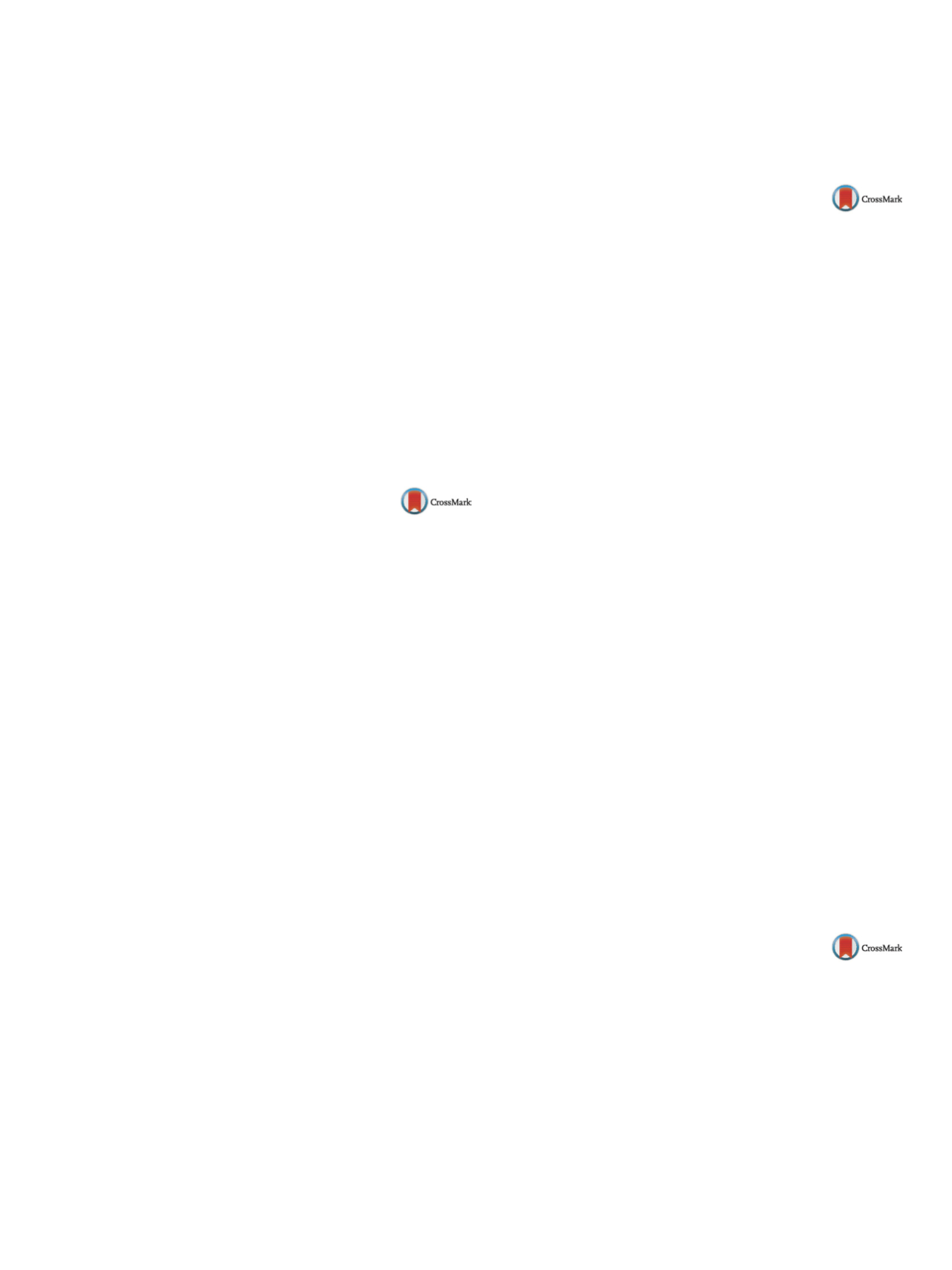

25th European Congress of Psychiatry / European Psychiatry 41S (2017) S238–S302
S287
at intake and followed during outpatient treatment for an average
of 531 days. Eighty-three percent of the patients underwent cog-
nitive behavioral therapy, the families of 75% of the patients were
included in the treatment and 48% of the patients took antidepres-
sants (SSRI).
Results
Both body mass index at assessment and illness dura-
tion appeared to be independent factors significantly affecting
the outcome. The role of neuropsychological variables was
explored including cognitive performance in a multivariate anal-
ysis including BMI at intake, duration of illness and diagnostic
subtype. The inclusion in the model of the Wisconsin Sort-
ing Card Task performance and the central coherence index
(calculated by the Rey Figure Test) significantly increased the
prediction ability of the model for full remission at the end of
treatment.
Conclusions
This is the first study to show that neuropsycholog-
ical characteristics may predict treatment response in AN. These
data support the implementation of cognitive remediation tech-
niques in the treatment of AN.
Disclosure of interest
The authors have not supplied their decla-
ration of competing interest.
http://dx.doi.org/10.1016/j.eurpsy.2017.02.145EW0532
Prevalence and correlates of perceived
stress in young medical
undergraduates
A. Mih˘ailescu
1 ,∗
, V.P. Matei
2, L.M. Gâz˘a
3, C. Mihailescu
4,
M. Codreanu
31
University of Medicine and Pharmacy “Carol davila”, Medical
Psychology, Bucuresti, Romania
2
University of Medicine and Pharmacy “Carol davila”, Psychiatry,
Bucharest, Romania
3
Hospital of Psychiatry Prof dr Al. Obregia, Psychiatry, Bucharest,
Romania
4
CMI dr Mihailescu S. Cristian, Family Medicine, Bucharest, Romania
∗
Corresponding author.
Introduction
Emotional distress–specifically symptoms of anxi-
ety and/or depression–in undergraduatemedical student represent
a major health issue for university life and for the entire society,
as the onset of negative affectivity in young age is lowering qual-
ity of life of the affected individual and implicitly, the professional
evolution.
Objective
The purpose of this study is to investigate the
prevalence of perceived stress in medical undergraduates and rela-
tionship between perceived stress and emotional distress.
Methods
The study comprised a randomised population of 356
students from 1st and 2nd year in Faculty of Medicine who signed
the informed consent for the research. Mean age in the group was
20.04
±
0.9 years old. Instruments used in the study were self-rated
Zung Anxiety Scale and Zung Depression Scale and Perceived Stress
Scale. Data were analysed with SPSS 16. Statistical significance was
at
P
< 0.05.
Results
Perceived stress of medium and high intensity was found
in 62.5% of the students in the study. There is a significant effect of
perceived stress on presence of emotional distress (
F
(3,352)
= 36,431,
P
< 0.001). In the emotional distressed group, perceived stress in the
period before the exams session is predicting emotional distress in
the period of exams (academic stress) with OR = 1.145,
P
= 0.04, IC
95% = 1.006–1.303.
Conclusions
There is a high prevalence of perceived stress and
perceived stress in the period before session of exams is a predictive
factor for having emotional distress in session of exams. Therefore,
we are signaling the necessity of implementation of stress man-
agement programs inmedical undergraduates fromthe pre-clinical
years.
Disclosure of interest
The authors have not supplied their decla-
ration of competing interest.
http://dx.doi.org/10.1016/j.eurpsy.2017.02.146EW0533
Microstructural changes in patients
with Parkinson’s diseases and REM
sleep behavior disorder: Depressive
symptoms versus non-depressed
S. Mohammadi Jooyandeh
1 ,∗
, M.H. Aarabi
2, F. Rahmani
31
University Hospital Regensburg, psychiatry and psychotherapy,
Regensburg, Germany
2
Basir Eye Health Research Center, neuroscience, Tehran, Iran
3
Tehran University of Medical Sciences, Student’s Scientific Research
Center, Tehran, Iran
∗
Corresponding author.
Introduction
REM sleep behaviour disorder (RBD) is associated
with psychiatric symptoms, such as anxiety and depression. RBD
is characterized by loss of normal skeletal muscle atonia during
rapid eye movement (REM) sleep with prominent motor activity
and dreaming and is a usual symptom of the early stages of Parkin-
son’s disease (PD). Diffusion MRI connectometry was used to carry
out group analysis between age and gender matched PD patients
with RBD in with and without depression to characterize possi-
ble depression-relatedwhitemattermicrostructural changes in the
Parkinson patients with RBD.
Method
DWI images were obtained for 15 PD-RBD with depres-
sion and 27 PD-RBD without depression. This dataset was acquired
on a 3 Tesla Siemens scanner, producing 64 DWI at
b
= 1000 s/mm
2
and one b0 image. Diffusion MRI data were corrected for subject
motion, eddy current distortions, and susceptibility artefacts due
to the magnetic field inhomogeneity. DiffusionMRI connectometry
was conducted in a total of 27 subjects using percentage measure-
ment.
Results
PD-RBD Patients with depressive symptoms showed
decreased anisotropy (FDR < 0.05) in the fornix bilaterally, right
cingulum, inferior longitudinal fasciculus bilaterally, right corti-
cospinal tract and Genu of corpus callosum compared to PD-RBD
patients without depression.
Conclusion
Since RBD is considered to be an early symptom of
PD and also a marker of progression to PD, these results might PD-
RBD patients with depression may progress dementing processes
and visuospatial dysfunction earlier since fornix, cingulum and ILF
have proven to be associated with these cognitive dysfunctions
respectively.
Disclosure of interest
The authors have not supplied their decla-
ration of competing interest.
http://dx.doi.org/10.1016/j.eurpsy.2017.02.147EW0534
Light as an aid for recovery in
psychiatric inpatients: A randomized
controlled effectiveness pilot trial
N. Okkels
1 ,∗
, L. G. Jensen
2 , R. Arendt
3 , A.B. Blicker
3 , J. Hjortdal
4 ,P. Jennum
5 , S. Straszek
31
Aarhus University Hospital Risskov, Clinic for OCD and Anxiety,
Risskov, Denmark
2
Aarhus University, Department of Mathematics, Aarhus, Denmark
3
Aarhus University Hospital Risskov, Department of Affective
Disorders, Risskov, Denmark
4
Aarhus University Hospital, Department of Ophthalmology, Aarhus,
Denmark
5
Copenhagen University Hospital, Danish Center for Sleep Medicine,
Copenhagen, Denmark
∗
Corresponding author.


















